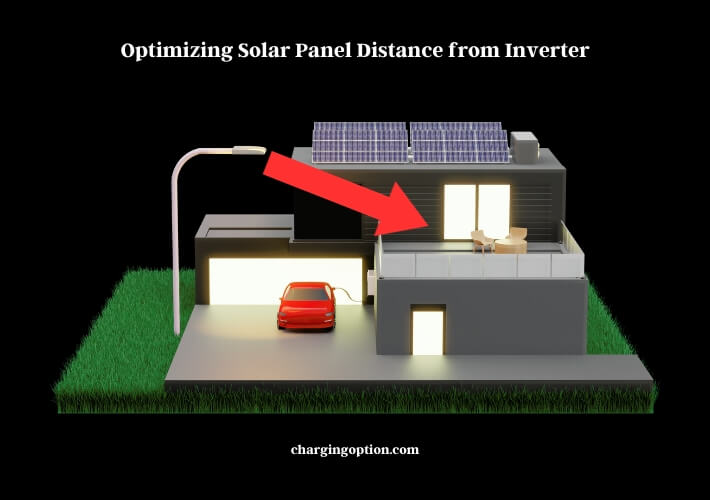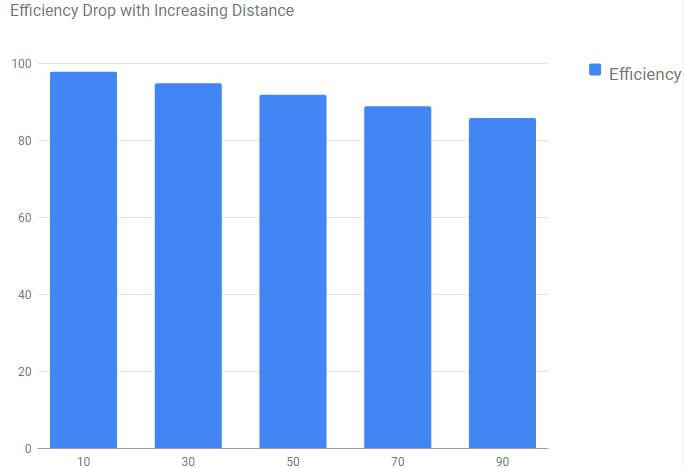Solar panels can typically be located up to 150 feet from an inverter. The distance largely depends on the type of wire and its gauge.
The efficiency and functionality of a solar power system can be influenced by the distance between its components. For instance, the maximum cable length for solar panels varies based on the type of wire used. The distance between solar panels and a charge controller is crucial, as longer distances might lead to power loss. Similarly, the distance between solar panels and a house can affect the efficiency of power transmission.
The relationship between the battery and inverter is also pivotal. The maximum distance between them should be minimized to ensure optimal power transfer. As for power loss over distance, it’s a factor that needs consideration, especially when setting up expansive solar farms or remote installations. The inverter’s distance from the meter can also play a role in the efficiency of the system.

Using the right wire is essential. For instance, 10 gauge solar wire can be run for specific distances without significant power loss. The type of wire used for solar panels can influence both the efficiency and safety of the system.
For a more detailed insight into these aspects and to optimize your solar installation, we invite you to read the detailed article below.
Background on Solar Panel and Inverter Dynamics
Basics of solar energy conversion
Solar energy is like nature’s gift to us, a vast and inexhaustible power source. Imagine the sun as a massive battery that’s been charging for billions of years. Every day, it provides more energy than we could use in a lifetime. Solar panels tap into this energy, converting sunlight into electricity. It’s like catching rays of sunshine and turning them into a usable power source for our homes and businesses.
Role of inverters in solar systems
Think of inverters as the bridge between the solar panels on your roof and the electronic devices in your home. Solar panels produce direct current (DC) electricity. Yet, most of our appliances use alternating current (AC). Inverters play the crucial role of converting DC into AC, ensuring that the energy harvested from the sun can power our modern world.
Factors Determining Optimal Distance
Wire gauge and its impact
Wire gauge is like the width of a water pipe. Just as a wider pipe can carry more water, a thicker wire can transmit more electricity. But there’s a catch. The longer the wire, the more resistance it offers, which can lead to energy loss. So, choosing the right wire gauge is essential to ensure minimal power loss, especially over longer distances.
Environmental conditions and their influence
Ever noticed how some materials expand in the heat and contract in the cold? Wires are no different. Extreme temperatures can affect their conductivity. Humidity, too, can play a role. It’s like wearing a thick coat on a hot day; it’s not the best match. Similarly, using standard wires in extreme conditions might not be the best choice.
System size and capacity considerations
It’s like fitting a square peg in a round hole; not all solar setups are the same. The distance between the solar panels and the inverter can vary based on the system’s size and capacity. Larger systems might require thicker wires and more strategic placement to ensure optimal performance.
Types of Wires and Their Limitations
Copper vs. Aluminum – Pros and Cons
Copper and aluminum are like the two popular kids in the world of electrical wiring. Copper, being a better conductor, is often preferred for its efficiency. It’s like the star athlete who always delivers. On the other hand, aluminum is lighter and less expensive, but it might not perform as well under certain conditions.
Wire insulation and its role in distance
Insulation is like the protective shield for wires. It prevents electrical leaks and protects the wire from external factors. The type of insulation can influence how far you can place your solar panels from the inverter. Some insulations are better suited for longer distances, while others are ideal for shorter spans.
Efficiency Implications of Distance
Power loss over varying distances
The longer the distance electricity has to travel, the more power it loses along the way. It’s like running a marathon; the longer you run, the more energy you expend. Similarly, as electricity travels through wires over greater distances, some of it gets lost due to resistance.
Impact on overall system performance
A solar system’s performance is like a well-coordinated dance. Every component needs to be in sync. If the distance between the solar panels and the inverter is too great, it can lead to inefficiencies. It’s essential to strike the right balance to ensure the system performs at its peak.
Practical Recommendations for Installation
Best practices for residential setups
For home setups, it’s like setting up a home theater. You wouldn’t place the speakers too far from the TV, right? Similarly, for optimal performance, it’s best to keep the solar panels relatively close to the inverter. This ensures minimal power loss and maximizes efficiency.
Considerations for commercial installations
Commercial setups are a whole different ball game. It’s like comparing a home kitchen to a restaurant kitchen. The scale is larger, and the requirements are different. For commercial installations, careful planning is crucial. The distance between the solar panels and the inverter, the type of wire used, and its gauge all play a significant role in the system’s efficiency.
Data Insights
Comparison of Different Wire Gauges and Maximum Distances
| Wire Gauge | Maximum Distance (ft) |
|---|---|
| 10 AWG | 30 |
| 8 AWG | 50 |
| 6 AWG | 85 |
| 4 AWG | 130 |
Efficiency Drop with Increasing Distance

Tools for Solar Installers
Calculator: Estimating Power Loss Based on Distance and Wire Type
Distance (in feet): Wire Type:Infographic: Quick Guide on Choosing the Right Wire
Copper
Best for short distances, higher efficiency.
Aluminum
Lighter, cost-effective, ideal for longer spans.
Insulation
Protects against external factors, crucial for longer distances.
How Does PV Optimization Affect Solar Charge Controller Function?
PV solar charge controller function is vital for efficient energy production. By optimizing the PV system, the charge controller can effectively manage the incoming solar energy to prevent overcharging and increase battery longevity. This ensures that the pv solar charge controller operates at its best capacity, maximizing energy utilization.
Safety and Regulatory Considerations
Electrical safety standards
Safety first! Just like you wouldn’t touch a hot stove, working with electricity requires caution. There are established electrical safety standards that need to be followed. These standards ensure that solar installations are safe for both the installers and the end-users. From the type of wire used to its insulation, every detail matters.
Building codes and regulations
Building a solar setup isn’t just about connecting panels to an inverter. It’s like constructing a house; you need to follow certain codes and regulations. Different regions might have different building codes that dictate how solar installations should be done. It’s always a good idea to be aware of these to ensure a smooth and compliant installation process.
Harnessing the sun’s energy is an art and a science. From choosing the right wire to determining the optimal distance between solar panels and inverters, every detail plays a role in the efficiency of the system. By keeping in mind the factors discussed in this guide, one can ensure a solar setup that not only performs well but is also safe and compliant with regulations. Whether you’re setting up a small residential system or a large commercial installation, knowledge is power. And in the world of solar energy, that power shines bright!
